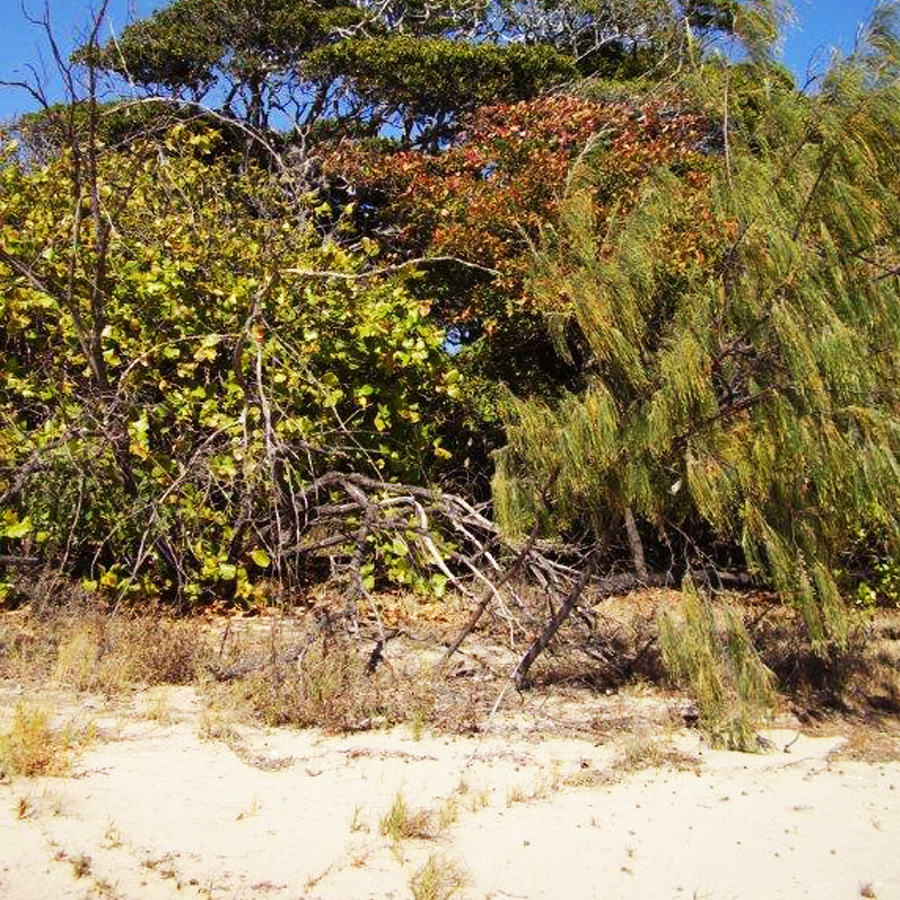Beach Scrub
Littoral Rainforest and Coastal Vine Thickets of Eastern Australia Ecological Community
Conservation Status:
Queensland State: Endangered
Australian Government: Critically Endangered
Species and status overview
Beach scrub is considered critically endangered and can be found in small scattered patches hugging the mainland and islands of the region. Beach scrub stabilises sand dunes and can protect coastal communities and inland vegetation from storm surges.
Beach Scrub has been recorded within the local area in small disjoint patches along the coastline stretching from Gloucester Island to Clareview and on most islands off the coast of the Whitsundays and Mackay. Beach Scrub can only be found within two km of the coast from Cape York to Victoria.
Description
The height the Beach Scrub canopy varies between 1-25m, which is dependent on the level of exposure to external factors, such as salt laden winds. Its canopy consists primarily of rainforest species on coastal dunes with trees such as the Burdekin plum, bottle tree, red condoo, scaly ash, tuckeroo and in some places brown tulip oak. Often there is a low tree or shrub layer and the ground layer is usually sparse but may have ferns, crinum or blue-flax lilies or Australian basket grass. Vines are common and epiphytes such as the golden orchid may also be found.
This ecosystem provides habitat for endangered and vulnerable animals such as the Proserpine rock-wallaby, northern quoll, striped-tailed delma (a legless lizard), pied imperial-pigeon, osprey, beach stone-curlew, sea turtles and some of our more common creatures such as the orange-footed scrubfowl, whose mounds made of leaves and twigs scraped from the forest floor can weigh up to 50 tonnes.
Conservation concerns
The main threats to this community include clearing for coastal, industrial and agricultural development. Visitor disturbance, fire, weeds and the effect of fragmentation are also contributing conservation concerns. Natural disturbances, such as storms and cyclones can impact this vegetation and with the potential increases in frequency and intensity associated with climate change, these disturbances may become more significant..
Transformer weeds are a subset of invasive plants (only ten percent) that change the character, condition, form or nature of a natural ecosystem over a substantial area. Within the Mackay-Whitsunday region, Rubber vine (Cryptostegia grandiflora), Lantana (Lantana camara), Guinea grass (Megathyrsus maximus) and corky passion-flower (Passiflora suberosa) are all considered transformer weeds. These weeds often form mono-specific (single species) stands and in some cases (e.g. Lantana) may increase threats form other sources such as fire.
Threats
- Habitat destruction and fragmentation for coastal development agricultural or industrial purposes
- Degradation of habitat by invasive weeds such as rubber vine, lantana and Guinea grass
- Disturbance by visitors including camping and 4WD vehicles
- Inappropriate fire – Beach scrub is highly sensitive to fire.
What can I do?
- Maintain or enhance existing habitat through revegetation or weed control.
- Apply appropriate fire management practices in adjacent vegetation. Be aware of the presence of fire promoting weeds such as Guinea grass when burning near beach scrub (refer to the Clarke Connors Range Fire Management Guidelines for guidance). Chemical or mechanical control prior to burning these areas may be necessary. Burn back from the edges of this ecosystem in areas where they are in relatively good condition. Little or no scorch is an indicator of successful fire management.
- Avoid driving through beach scrub areas, this can lead to erosion and weed infestations.
Photo credit Kerensa McCallie
